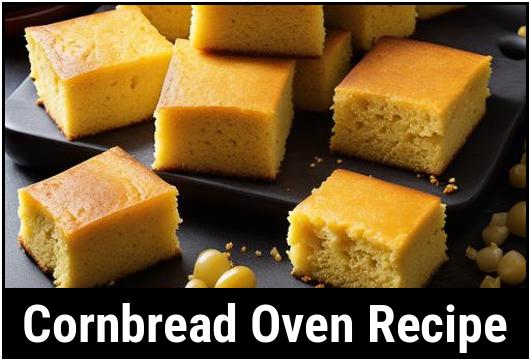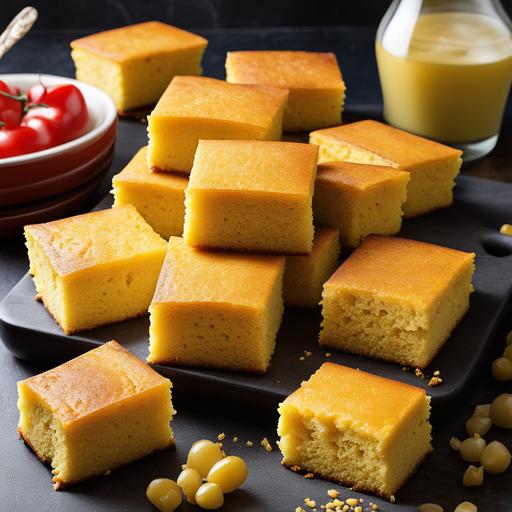
Cornbread Oven Recipe: A Delicious And Wholesome Delight
Cornbread, a staple in many kitchens across the globe, is a delightful and versatile dish that can be enjoyed as a main course, a side dish, or even as a snack on its own. Whether you’re a seasoned home cook or just starting your culinary journey, this informative and comprehensive article will take you through the art of making cornbread in the oven. We will explore the food science behind cornbread, discuss culinary details, share tips and variations, and guide you through the process from selecting the ingredients to the final touch of doneness checks. So, let’s dive in and discover the secrets to creating the perfect cornbread!
The Science Behind Cornbread
Cornbread is a unique combination of ingredients that creates a delightful harmony of flavors and textures. The main ingredient, cornmeal, is ground from dried corn kernels and provides the distinct corn flavor and slightly gritty texture to the bread. Other key ingredients like eggs, milk, and butter add richness and moisture to the cornbread.
When the cornbread batter is placed in the oven, a beautiful transformation takes place due to the heat. The proteins in the eggs and flour coagulate, causing the bread to rise and set. The heat also causes the starches in the cornmeal to absorb moisture, resulting in a moist and tender cornbread.
Culinary Details for the Perfect Cornbread
Ingredient Selection
Selecting high-quality ingredients is crucial for achieving a delicious cornbread. Let’s explore the key ingredients and their best choices:
-
Cornmeal: Opt for stone-ground cornmeal for a more authentic and textured cornbread. You can choose yellow or white cornmeal based on your preference.
-
Flour: All-purpose flour works well in most cornbread recipes. For a gluten-free option, consider using a gluten-free flour blend.
-
Eggs: Use large eggs for the best results. Fresh eggs will provide a richer flavor.
-
Milk: Choose whole milk or buttermilk for a moist and creamy texture. However, if you prefer a lighter cornbread, you can use low-fat milk.
-
Butter: Unsalted butter is preferred as it allows you to control the salt content. However, if you only have salted butter, adjust the added salt accordingly.
-
Sweetener: Traditional cornbread is not sweetened, but if you enjoy a touch of sweetness, consider adding a small amount of honey or sugar.
Cleaning and Preparation
Before starting your cornbread-making adventure, it’s essential to ensure your cooking equipment and utensils are clean. This includes thoroughly cleaning the oven, baking dish, mixing bowls, and any other utensils you’ll be using. Cleanliness is crucial to prevent any unwanted flavors or contaminants from affecting your cornbread.
Once your equipment is clean, it’s time to preheat the oven. Set the temperature to 375°F (190°C) to ensure optimal heat distribution for baking the cornbread evenly.
Tips and Variations
Creating the perfect cornbread comes down to a combination of technique and personal preferences. Here are some tips and variations to consider:
-
Moisture Control: Cornbread should have a moist and tender crumb. To achieve this, avoid overmixing the batter. Overmixing develops gluten, resulting in a denser texture. Mix the ingredients until they are just combined.
-
Enhancing the Flavor: For an extra flavor boost, consider incorporating add-ins such as grated cheese, diced jalapeños, corn kernels, or herbs like thyme and rosemary. Experiment with your favorite flavors to create a unique cornbread recipe.
-
Texture Variation: Cornbread can be made in various textures, ranging from light and cake-like to dense and crumbly. Adjust the cornmeal-to-flour ratio to achieve the desired texture. More cornmeal will yield a coarser and grittier texture, while additional flour will result in a finer and softer crumb.
-
Gluten-Free Option: If you’re following a gluten-free diet, replace the all-purpose flour with a gluten-free flour blend. Ensure that the blend contains xanthan gum or add it separately as a binding agent to prevent the cornbread from crumbling.
-
Vegan Adaptation: For a vegan-friendly version, substitute the eggs with a flaxseed or chia seed egg substitute and use plant-based milk and butter alternatives. Ensure the proportions are in line with the recipe guidelines for the best results.
Checking Doneness: The Crucial Step
The key to a successful cornbread lies in determining its doneness. To check if your cornbread is fully cooked, insert a toothpick or a thin knife into the center of the bread. If it comes out clean or with a few moist crumbs clinging to it, your cornbread is ready. If the toothpick or knife comes out with wet batter, continue baking the cornbread for a few more minutes and recheck.
Overcooking and Undercooking
Be mindful not to overcook or undercook your cornbread. Overcooking can result in a dry and crumbly texture, while undercooking may leave the center raw and unappetizing. It is important to follow the recommended baking time provided in your recipe and rely on the toothpick or knife test for precise doneness.
The Perfect Cornbread Oven Recipe

Now that we have explored the science, culinary details, and crucial steps behind making cornbread, let’s jump into a classic cornbread oven recipe that will surely satisfy your taste buds.
Ingredients:
-
1 cup yellow cornmeal
-
1 cup all-purpose flour
-
1 tablespoon baking powder
-
1/2 teaspoon salt
-
1 cup whole milk
-
2 large eggs
-
1/4 cup unsalted butter, melted
Instructions:
-
Preheat the oven to 375°F (190°C). Grease a 9-inch square baking dish or cast-iron skillet.
-
In a large mixing bowl, whisk together the cornmeal, flour, baking powder, and salt until well combined.
-
In a separate bowl, whisk together the milk, eggs, and melted butter until thoroughly blended.
-
Pour the wet ingredients into the dry ingredients and gently stir until just combined. Do not overmix; a few lumps are okay.
-
Pour the batter into the prepared baking dish or skillet, spreading it evenly.
-
Bake for 20-25 minutes or until the cornbread is golden brown and a toothpick or knife inserted into the center comes out clean or with a few crumbs clinging to it.
-
Remove from the oven and let it cool for a few minutes before cutting into squares or wedges.
-
Serve warm and enjoy the deliciousness of homemade cornbread!
Conclusion
Cornbread holds a special place in the hearts of many food lovers, and now you have the knowledge and tools to prepare it to perfection in your own kitchen. From understanding the food science behind cornbread to selecting the right ingredients, preparing the batter, and checking for doneness, this comprehensive guide covers all the important aspects.
Remember, don’t be afraid to experiment with different flavors and textures to make your cornbread truly unique. Share your creations with friends and family, and let the comforting aroma of freshly baked cornbread fill your kitchen. Embrace the art of cornbread-making, and savor every bite of this delightful and comforting culinary wonder!
Sources
FAQS On Cornbread Oven Recipe
What Ingredients Do I Need To Make Cornbread In The Oven?
The basic ingredients for cornbread are cornmeal, flour, sugar, baking powder, salt, milk, eggs, and melted butter. You may also add in other ingredients such as cheese, jalapenos, or corn kernels to give your cornbread more flavor and texture.
What Is The Ideal Temperature For Baking Cornbread In The Oven?
The ideal temperature for baking cornbread in the oven is 400 degrees Fahrenheit. This will ensure that your cornbread is cooked evenly and has a golden brown crust.
How Long Should I Bake My Cornbread In The Oven?
The baking time for cornbread can vary depending on the size and shape of the pan you are using. Generally, it takes about 20-25 minutes for a 9-inch square pan or 12-15 minutes for muffin cups. Test for doneness by inserting a toothpick into the center of the bread, if it comes out clean, it’s done!
Can I Make Cornbread In Advance?
Yes, you can make cornbread in advance. Once your cornbread has cooled down to room temperature, wrap it tightly in plastic wrap or aluminum foil and store it in the fridge for up to 3 days. You can also freeze cornbread and keep it for up to one month.
How Can I Make My Cornbread Moist And Fluffy?
To make your cornbread moist and fluffy, you can replace some of the milk with sour cream or buttermilk, which adds richness and tanginess to the batter. Another option is to add a can of creamed corn to the batter, which will add moisture and flavor to the cornbread. Lastly, avoid overmixing the batter, as this can result in tough and dense cornbread.


